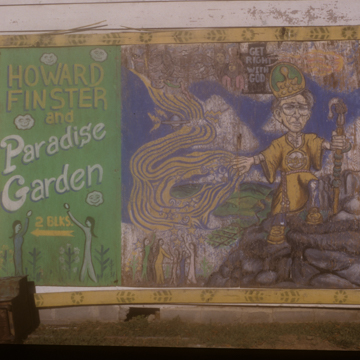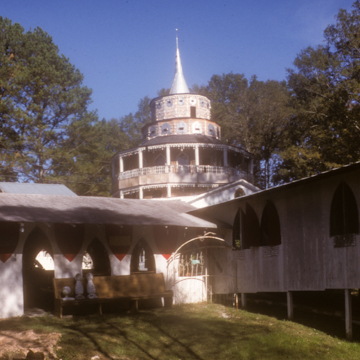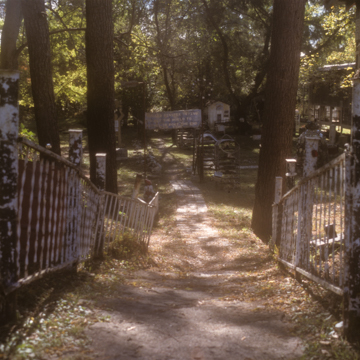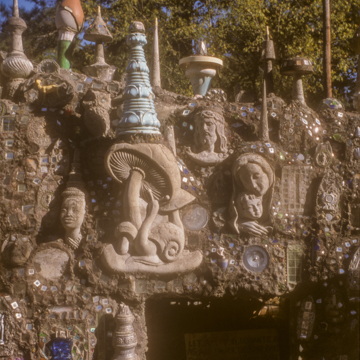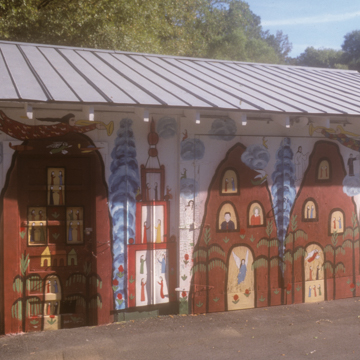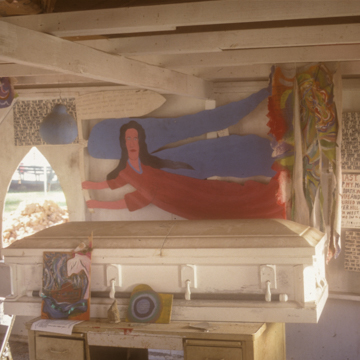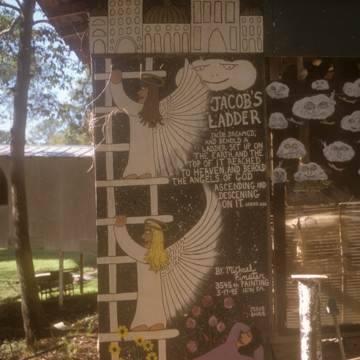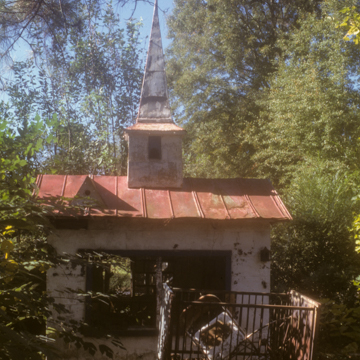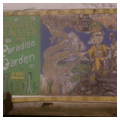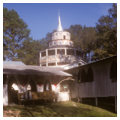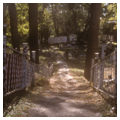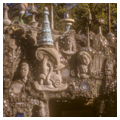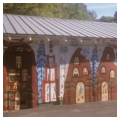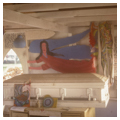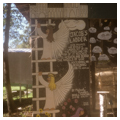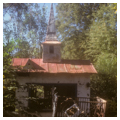You are here
Paradise Garden
Paradise Garden was the workshop and residence of folk artist Howard Finster, a minister whose artistic expression created an outsider art of found objects, religious inscriptions, paintings of angels, American flags, and other symbols of his personal morality. In 1961 Finster purchased a four-acre site, constructed canals to drain the property’s swamp, built or moved buildings to the garden to house his art (or provide wall surfaces for his murals), and began to collect discarded household objects as material for his art. In 1976 Finster experienced a profound “vision” that encouraged him to put aside all other activities in order to dedicate his life to sacred art. From then until his death, his was a world that balanced the everyday with fantasy, the familiar objects of this earth with his personal visionary world.
Finster is difficult to categorize in artistic terms. He is a folk artist, untrained, whose work is now in major private collections of Southern art and in museums throughout the country. His work is “Southern Gothic” in its artistic use of decayed possessions, rusting junk, and discarded fragments of machines, household objects, and no longer useful or desirable objects. His art is both “pop” and sacred; his album covers for rock bands R.E.M. and Talking Heads spread his reputation to millions. His medium is rarely singular, crossing traditional distinctions: paintings that balance extensive calligraphic text and inscriptions with flat figural representations; sculpture that becomes architectural in scale and is intended to “house” local animals, insects, reptiles, or any living thing in need of shelter; and a subject matter that is both naive and profound, earthy and visionary. His art is ad-hocist and sometimes ephemeral while intended to convey a message of urgency and timeless significance.
Finster believed the world began in a paradise garden and would end in a garden; his art was therefore preparatory and his warnings sincere. Although he called himself “God’s junkman,” he also considered himself a second Noah, here to save the world through the sermon of his art. Interspersed throughout the garden and buildings are mini-sermons, inscriptions expressing the common theme of salvation and his call to embrace Jesus Christ. On buildings, wooden boards, and other surfaces, Finster’s art became mural art, signage, and billboards. He painted angels surrounded by Biblical quotations or texts preaching his own message to “Get Right With God.” Throughout his garden and by means of his art, he warned visitors that the day of reckoning should be of serious concern.
Finster’s garden studio had no master plan but simply evolved, and exists today as his most notable art work. He built structures to house his sign paintings, decorated the edifices as mural art, and then allowed the buildings to deteriorate. He negotiated the purchase of a chapel and subsequently made it the focus of his paradise. He surrounded it with art-bordered paths, set posts in the ground with inscribed messages arranged like a sequence of sacred Burma-Shave roadside advertisements, and, interspersed throughout the garden, he erected mounds, walls, and sculptural compositions of discarded paraphernalia. Finster built a sculptural tower of rusting bicycle parts and he also fabricated a huge bird cage out of refrigerator metal shelving. He amassed a multitude of materials and embedded in crude concrete garden walls objects ranging from costume jewelry, figural heads, toys and sundries, to recycled materials, broken ceramics, soda pop bottles, and other shards of twentieth-century civilization (and in this, Finster’s potsherd walls call to mind Watts Towers in Los Angeles). The most distinctive character of his art, however, was found in the juxtaposition of religious and moral messages with figural representations of individuals including religious leaders (Jesus, John the Baptist, Buddha), United States presidents (George Washington, Ulysses S. Grant, Teddy Roosevelt, Harry Truman, and John F. Kennedy), literary figures (Shakespeare), icons of popular culture (Elvis), as well as representations of UFOs and aliens. Both earthly and otherworldly, Finster’s paradise garden was personal and universal.
References
Goodman, Brenda. “Saving a Folk Artist’s Paradise, Lost to Weeds and Ruin, Is a Tangled Affair.” New York Times, October 25, 2007.
Peacock, Robert, with Annibel Jenkins, Paradise Garden: A Trip Through Howard Finster’s Visionary World. San Francisco: Chronicle Books, 1996.
Writing Credits
If SAH Archipedia has been useful to you, please consider supporting it.
SAH Archipedia tells the story of the United States through its buildings, landscapes, and cities. This freely available resource empowers the public with authoritative knowledge that deepens their understanding and appreciation of the built environment. But the Society of Architectural Historians, which created SAH Archipedia with University of Virginia Press, needs your support to maintain the high-caliber research, writing, photography, cartography, editing, design, and programming that make SAH Archipedia a trusted online resource available to all who value the history of place, heritage tourism, and learning.














